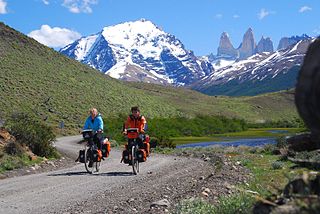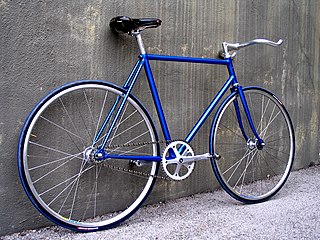
Cycling, also known as bicycling or biking, is the activity of riding a bicycle or other type of cycle. It encompasses the use of human-powered vehicles such as balance bikes, unicycles, tricycles, and quadricycles. Cycling is practised around the world for purposes including transport, recreation, exercise, and competitive sport.

Bicycle touring is the taking of self-contained cycling trips for pleasure, adventure or autonomy rather than sport, commuting or exercise. Bicycle touring can range from single-day trips to extended travels spanning weeks or months. Tours may be planned by the participant or organized by a tourism business, local club or organization, or a charity as a fund-raising venture.

Bicycle messengers are people who work for courier companies carrying and delivering items by bicycle. Bicycle messengers are most often found in the central business districts of metropolitan areas. Courier companies use bike messengers because bicycle travel is less subject to unexpected holdups in city traffic jams, and is not deterred by parking limitations, fees or fines in high-density development that can hinder or prevent delivery by motor vehicle, thereby offering a predictable delivery time.

The car-free movement is a broad, informal, emergent network of individuals and organizations, including social activists, urban planners, transportation engineers, environmentalists and others, brought together by a shared belief that large and/or high-speed motorized vehicles are too dominant in most modern cities. The goal of the movement is to create places where motorized vehicle use is greatly reduced or eliminated, by converting road and parking space to other public uses and rebuilding compact urban environments where most destinations are within easy reach by other means, including walking, cycling, public transport, personal transporters, and mobility as a service.

A fixed-gear bicycle is a bicycle that has a drivetrain with no freewheel mechanism such that the pedals always will spin together with the rear wheel. The freewheel was developed early in the history of bicycle design but the fixed-gear bicycle remained the standard track racing design. More recently the "fixie" has become a popular alternative among mainly urban cyclists, offering the advantage of simplicity compared with the standard multi-geared bicycle.

Bicycle culture can refer to a mainstream culture that supports the use of bicycles or to a subculture. Although "bike culture" is often used to refer to various forms of associated fashion, it is erroneous to call fashion in and of itself a culture.

Bicycle Network is an Australian charity, one of the largest cycling membership organisations in the world, whose mission is to have More People Cycling More Often. Before 2011 it was known as Bicycle Victoria.

Cycling in Melbourne is an important mode of transport, fitness, sport and recreation in many parts of the city. After a period of significant decline through the mid to late 20th century, additional infrastructure investment, changing transport preferences and increasing congestion has resulted in a resurgence in the popularity of cycling for transport. This is assisted by Melbourne's natural characteristics of relatively flat topography and generally mild climate.

Vehicular cycling is the practice of riding bicycles on roads in a manner that is in accordance with the principles for driving in traffic, and in a way that places responsibility for safety on the individual.

Since the advent of the bicycle in the 1860s, Chicago has been distinguished as one of the premier cycling locations in the United States, with such public cycling destinations as Grant Park, Burnham Park and the Chicago Park District's Lakefront Trail.

A ghost bike is a bicycle roadside memorial, placed where a cyclist has been killed or severely injured, usually by the driver of a motor vehicle.
Critical Mass Melbourne is an informal grass roots collection of people who gather to take part in the month's Critical Mass event, which is a cycling event typically held in various cities throughout the world on the last Friday of every month, for traveling as a group through city or town streets on bikes. The rides in Melbourne began in November 1995, and have occurred every month since, with between 100 and 1000 riders involved. Like most Critical Mass events in other cities, the Melbourne rides have fostered the development of a coherent urban cycling community, the focus of which is the temporary intentional community of the rides themselves.

Cycling is a popular mode of transport and leisure activity within London, the capital city of the United Kingdom. Following a national decline in the 1960s of levels of utility cycling, cycling as a mode of everyday transport within London began a slow regrowth in the 1970s. This continued until the beginning of the 21st century, when levels began to increase significantly—during the period from 2000 to 2012, the number of daily journeys made by bicycle in Greater London doubled to 580,000. The growth in cycling can partly be attributed to the launch in 2010 by Transport for London (TfL) of a cycle hire system throughout the city's centre. By 2013, the scheme was attracting a monthly ridership of approximately 500,000, peaking at a million rides in July of that year. Health impact analyses have shown that London would benefit more from increased cycling and cycling infrastructure than other European cities.

Cycling in Sydney, New South Wales, Australia takes place for recreation, commuting and as a sport. Sydney has a hilly topography and so may require a slightly higher level of fitness from cyclists than flatter cities such as Melbourne and Canberra. Sydney depends heavily on motor vehicles where traffic and public transport operate at capacity. This means that cyclist are often competing with motorists for limited space on busier roads, and for limited government resources for expenditure on road infrastructure. In its favour, Sydney has a generally mild climate and there are active cycling groups.

Cycling in New York City is associated with mixed cycling conditions that include dense urban proximities, relatively flat terrain, congested roadways with stop-and-go traffic, and streets with heavy pedestrian activity. The city's large cycling population includes utility cyclists, such as delivery and messenger services; cycling clubs for recreational cyclists; and increasingly commuters. Cycling is increasingly popular in New York City; in 2018 there were approximately 510,000 daily bike trips, compared with 170,000 daily bike trips in 2005.
There have been many conflicts during Critical Mass events since the founding of the worldwide bicycling advocacy event in 1992. The conflicts have resulted in injuries, property damage, and arrests, and both bicyclists and motorized vehicle drivers have been victims. Critics say that Critical Mass, held primarily in large metropolitan cities, is a deliberate attempt to obstruct automotive traffic and disrupt normal city functions, when individuals taking part refuse to obey traffic laws, while participants variously consider it a celebration of cycling, of cyclists' rights, and a practical re-imagining of urban space.

Cycling in San Francisco has grown in popularity in recent years, aided by improving cycling infrastructure and community support. San Francisco's compact urban form and mild climate enable cyclists to reach work, shopping, and recreational destinations quickly and comfortably. Though San Francisco's famed steep hills can make cycling difficult, many parts of the city are relatively flat, including some of the most densely populated. However, heavy automobile traffic, the lack of bike lanes on many streets, and difficulty in crossing major streets deter most residents from cycling frequently in San Francisco.

Cycling in Atlanta has grown in popularity in recent years, from 0.33% of commutes in 2000 to 1.1% in 2009, aided by improving cycling infrastructure and community support. Although Atlanta has historically been a city defined by the automobile, its increasingly compact urban form and mild climate are encouraging residents to cycle to work, shopping, and recreational destinations. Though Atlanta's famed hilly topography can make cycling challenging, though fun, many parts of the city are relatively flat, including some of the more densely populated areas. However, heavy automobile traffic, the lack of bike lanes on many streets, and difficulty in crossing major streets deter most residents from cycling frequently in Atlanta.

San Jose Bike Party is a monthly social bicycle ride event in and around San Jose, California held on the third Friday of every month. Attendance varies with weather and time of year, usually ranging from hundreds in the winter months to low thousands in the summer. Established in 2007, it is the original 'bike party' now replicated in other cities around the world. Its motto is "Building community through cycling".

San Jose, California has various cycling routes on roads and trails used by both commuters and recreational riders. The city has plans to expand the current 285 miles (459 km) of bike lanes to 400 miles (640 km), and the current 60 miles (97 km) of trails to 100 miles (160 km). San Jose was ranked as a bronze-level bicycle-friendly community by the League of American Bicyclists.






















